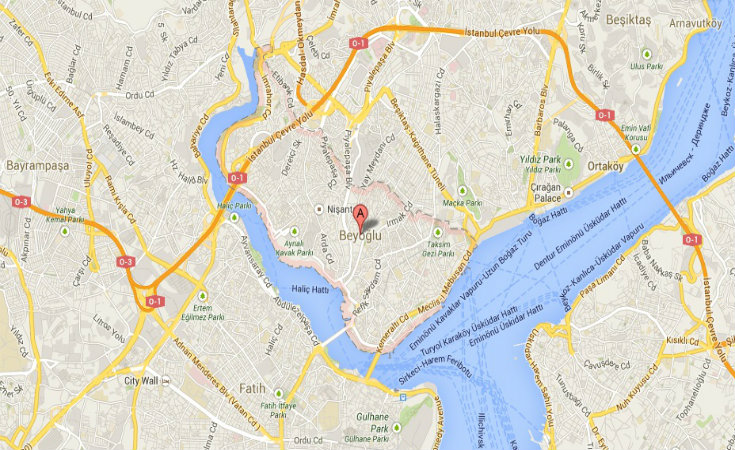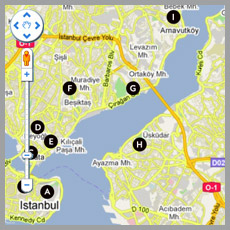LIVELY, BOHEMIAN BEYOĞLU
Located on the European side of Istanbul, the district of Beyoğlu borders the district of Şişli to the north, the district of Beşiktaş and the Bosphorus to the east, the districts of Kağıthane and Eyüp to the north-west and the Golden Horn to the south. 8.76 km² in size, the district comprises 45 neighbourhoods.
Beyoğlu is one of the liveliest and most colourful districts of Istanbul. The lively nightlife and good range of acommodation attracts both locals and tourists alike throughout the year. This area on the other side of the Golden Horn from the Historical Peninsula has always been referred to as Pera, Greek for ‘the other side’. The name Beyoğlu used by Turks is attributed to the mansion of a Turkish lord’s (bey’s) son and depending on the story he was either the Prince of Pontus who converted to Islam during the time of Mehment II or the son of the Venetian envoy during the time of Suleiman I. The name Pera was gradually forgotten after it was omitted from official correspondences in 1925 when Beyoğlu started to become popularly used.
In contrast to nearby Galata’s history which extends way back, Beyoğlu was an area of greenery and gardens with few buildings during the first half of the 16th century. It started to become a settlement in the style of a European city as Christians and non-Turks from Galata came and built embassies along the length of Istiklâl Avenue, referred to as Grand Rue de Pera back then. The core of the area was formed by French and Venetian embassies and the Fransiscan missionaries that settled around them. In an engraving of Galata dating back to the early 17th century, few buildings can be seen outside the city walls. Thus, a different community began to develop within Istanbul during the 17th century.
By 1700 Beyoğlu had extended on both sides of the current Tünel-Galatasaray route and the side streets that surrounded the main road. There were graveyards to its west and embassies to its east. In the 18th century the European influence gradually increased and by the end of the century buildings on Istiklâl Avenue were either entirely built of stone or brick, or had stone ground-floors and timber upper floors. (The Turkish community built almost exclusively in timber.)
The 20th century saw the area between Galatasaray and Taksim gain importance and mansions with gardens were turned into apartment buildings and the area consequently developed. In 1913 the construction of the first electric tram between Beyoğlu and Şişli rendered the top section of Istiklâl Avenue an easy to access and favoured area. During this period new neighbourhoods were developed in the areas surrounding Beyoğlu with the facades of the apartment buildings constructed boasting Art Nouveau features.
Historical places, temples and important sights
Church of St. Anthony of Padua
The construction of the church was completed on August 23rd, 1906, by Giulio Mongeri, an architect who was born in İstanbul. It is the most important Catholic church in İstanbul and it is administered by Italian priests. It was opened to prayer on the 15th of February, 1912. The dimensions of the church are 20 x 50 meters and it was built in neo-gothic style in the shape of a Latin cross. The interior walls are covered with mosaics up to a certain point, while the exterior of the church is brick.
Ottoman Bank
A part of the plot that was owned by the Ottoman Tobacco Company on Voyvoda Street was given to the Ottoman Bank at the end of the 1880s and the Levantine architect Alexandre Vallaury was assigned to plan buildings for both of the institutions on the premises. A steel safe with three levels and four doors, the lock system of which still inspires experts today, was brought from London and the building was constructed on top of this safe room. In the construction of the safe room, 1 cm thick sheet metal was used, and the outer walls had three layers supported with 110 cm and 70 cm thick concrete profiles. The static calculations were based on these walls.
When it first opened, Ottoman Bank had vaults, warehouses and stables on the lowest floor; on the floor below the entrance was the safe that was made by the famous manufacturer Samuel Chatwood and the cafeteria; the clerks were housed on the entrance level; the private room and the office of the manager as well as the offices of his secretaries and translators were on the first floor; the offices for the accountancy service, government custodian and the inspectors were on the second floor and the catering service, archive and janitor rooms were in the loft.
The historic Ottoman Bank building has been hosting the Ottoman Bank Archive and Research Center since 2000. The Ottoman Bank Museum was founded in the building in 2002. It is considered one of the richest financial history museums in the world, and the initial project was pursued by the Ottoman Bank Archive and Research Center. The overall project for the museum was coordinated and supervised by historian Prof. Edhem Eldem, architect Prof. İhsan Bilgin and designer Bülent Erkmen.
Apartment Doğan
Located on Serdar-ı Ekrem Street, the apartment block was built in Italian style in 1895. It is named after Doğan Kardeş, who died in Switzerland while skiing and who was the son of Kazım Taşkent –the owner of the building at the time. The building was sold by Kazım Taşkent as 51 flats and 2 shops. The area that used to be a tennis court was sold separately as plot and it is now being used as a parking lot. The building with three wings around a yard consists of four blocks and it was built by a Belgian family of tobacco merchants over a period of twenty years, block by block. The building has a magnificent view and it has been frequently used as a set for films and television.
Camondo Stairs
This unique, late baroque influenced structure was built in the 1850s in order to elegantly connect Voyvoda Street (then the main street in Galata) and Rue Camondo (now Banker Street), which hosted the bank of one of the most prominent bankers in the district, Avram Camondo. The Jewish Camondo family of Portugese (or Spanish) origin is believed to have moved to İstanbul after living in various cities in Europe, probably at the end of the 18th century. The family soon became very prosperous through international trade. Though the family name appears in Ottoman documents as early as 1782, there is no detailed information on the family members and their activities.



















